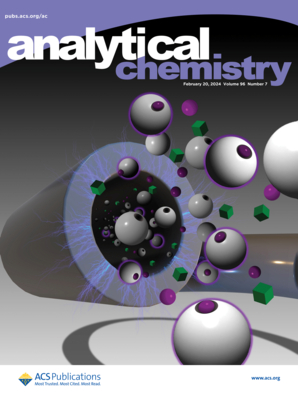Cas9/Switch-sgRNA复合物介导的近距离切割实验用于细胞外小泡蛋白敏感分析的高通量芯片
IF 6.7
1区 化学
Q1 CHEMISTRY, ANALYTICAL
引用次数: 0
摘要
小细胞外囊泡(sev)在调节各种疾病的病理过程中起着关键作用,并已成为疾病诊断的有希望的生物标志物,包括急性脊髓损伤和癌症。这是由于它们能够运输反映其亲本细胞分子特征的多种蛋白质。表面蛋白的评估提出了一个强大的策略,以确定一套全面的生物标志物。在这项研究中,我们开发了一种能够表征完整sev表面蛋白的高通量设备。我们的方法将CD63抗体固定在96孔板上,并将CD9适配体整合到switch-sgRNA中,促进了完整sev的有效捕获,并实现了随后的表面蛋白分析。该系统利用Cas9-nickase/switch-sgRNA复合物介导的近距离切割实验和身份探针,结合DNA聚合酶辅助的链延伸和位移,实现了对目标蛋白的高度特异性和精确鉴定。井内DNA聚合酶介导的链延伸和位移机制产生了多个富含g的序列,促进了基于ThT的无标记信号扩增。这种创新的设计使高通量芯片能够在完整的sev上分析表面蛋白EpCAM,具有卓越的灵敏度,实现了3.5颗粒/μL的极低检测限。此外,该芯片已成功应用于各种生物样品衍生的sev表面标记物的识别,包括EpCAM、PTK7、PDGF和PSMA,显示了其在高通量生物标记物发现和分析方面的巨大潜力。本文章由计算机程序翻译,如有差异,请以英文原文为准。
High-Flux Chip for Sensitive Profiling of Small Extracellular Vesicle Proteins by Cas9/Switch-sgRNA Complex-Mediated Proximity Cleavage Assay.
Small extracellular vesicles (sEVs) play pivotal roles in modulating the pathological processes of various diseases and have emerged as promising biomarkers for disease diagnosis, including acute spinal cord injury and cancers. This is attributed to their ability to transport multiple proteins that reflect the molecular signatures of their parent cells. The evaluation of surface proteins presents a robust strategy for identifying a comprehensive set of biomarkers. In this study, we developed a high-throughput device capable of characterizing surface proteins on intact sEVs. Our approach employs CD63 antibodies immobilized on a 96-well plate and a CD9 aptamer integrated into switch-sgRNA, facilitating the efficient capture of intact sEVs and enabling subsequent surface protein profiling. The system utilizes a proximity cleavage assay mediated by the Cas9-nickase/switch-sgRNA complex and an identity probe, combined with DNA polymerase-assisted chain extension and displacement, to achieve highly specific and precise identification of target proteins. The DNA polymerase-mediated chain extension and displacement mechanism within the wells generates multiple G-rich sequences, which facilitate Thioflavin T (ThT)-based label-free signal amplification. This innovative design allows the high-throughput chip to profile the surface protein EpCAM on intact sEVs with exceptional sensitivity, achieving a remarkably low detection limit of 3.5 particles/μL. Moreover, the chip has been successfully applied to identify surface markers including EpCAM, PTK7, PDGF, and PSMA on sEVs derived from various biological samples, demonstrating its significant potential for high-throughput biomarker discovery and analysis.
求助全文
通过发布文献求助,成功后即可免费获取论文全文。
去求助
来源期刊

Analytical Chemistry
化学-分析化学
CiteScore
12.10
自引率
12.20%
发文量
1949
审稿时长
1.4 months
期刊介绍:
Analytical Chemistry, a peer-reviewed research journal, focuses on disseminating new and original knowledge across all branches of analytical chemistry. Fundamental articles may explore general principles of chemical measurement science and need not directly address existing or potential analytical methodology. They can be entirely theoretical or report experimental results. Contributions may cover various phases of analytical operations, including sampling, bioanalysis, electrochemistry, mass spectrometry, microscale and nanoscale systems, environmental analysis, separations, spectroscopy, chemical reactions and selectivity, instrumentation, imaging, surface analysis, and data processing. Papers discussing known analytical methods should present a significant, original application of the method, a notable improvement, or results on an important analyte.
 求助内容:
求助内容: 应助结果提醒方式:
应助结果提醒方式:


